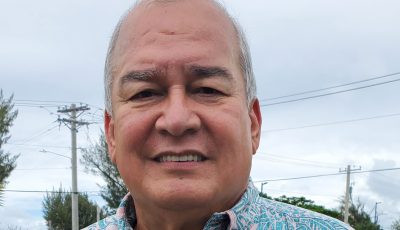Culture of self-government
There’s the culture of self-government, the aspired smaller central authority unlike the huge federal bureaucracy in Washington, D.C. It’s the belief that greater governance must reside in the states, cities, and counties, truthfully dignifying a “government of the people, by the people and for the people.”
But in our search for greater self-government, let’s take some ocular review of our footprints to critically evaluate our performance in strengthening our democratic institutions. It’s a sure way to planning the trip ahead in search of our aspirations for stronger self-government and far less command and dictates from the feds.
Economy: We did well during the boom years of the mid-’80s and ’90s. Then slowly the economy headed Deep South to where we are today with a cumulative deficit of over $600 million. This as revenue generation struggles inching upwards to about $126 million last fiscal year. Has the NMI reined in major capital investment since 2005? Nah! Is the fiscal impotence an issue to be concerned about? Pen your view here.
The persistent waltz with mediocrity ignores the importance or essence of new capital investment. Have we buckled down to critically reviewing predatory and regressive tax and other pertinent policies? Or is this task way above the heads of policymakers who prefer basking in the sea of “do-nothing” in perpetuity? Isn’t the NMI in dire fiscal straits, therefore the next most urgent agenda is to rein in capital investment to ease the hardship at the village level?
Isn’t the NMI equally a laboratory of economic freedom? Have we been realistic and prudent in this respect or have we buried our heads, time and again, in mediocrity? Don’t you think our people are tired of “do-nothings” who repeat stale rhetoric?
Accountability: If we’re true to the commitment of greater self-government, what have we done to cut the habit of spending on expenses we could ill afford? Have we succeeded downsizing the bicameral legislative system that cost over $4.8 million annually? Have we cut down the salaries of the Tinian Gaming Commission to decent level over the prevailing $100K per year doing, yes, nothing?
Have we stopped traveling if only to admit the bankruptcy of the local government? Have we downsized the bloated public payroll? Who bankrupted the retirement program? Is there a chance to restore the 25-percent cut in pension pay? Didn’t health premium and the entire nine yards just increased by 40-45 percent? Isn’t fiscal responsibility a major obligation under the concept of self-government? What’s our performance rating on this score?
We’ve also accepted federal programs that look sound, initially ignoring that when funds taper off we’d end up saddling the local government with more debts upwards of $200 million. Have we ably cleared any portion of the cumulative deficit of $561 million? Yet, we wish to pile up more debts with pension obligation bond to the tune of $60 million to $80 million? This isn’t the responsible thing to do, is it? Then we boast of turning the NMI into a welfare state. Is this our future, an archipelago of beggars? How about reviving the culture of responsibility?
It’s clear our journey over the last 36 years has been problematic and remains so today. The issues we’ve piled with local inadequacies aren’t very encouraging when measured against spouts for greater self-government. Or is it a case of elected offices attracting fools, knaves and power-hungry mediocre types? Perhaps it’s just as appropriate to begin learning to own up to our responsibilities.
The future: If paradigms remain stuck in the abyss of apathy and lack of conscious leadership then it stands to reason that there’s not much to be optimistic about in terms of the future of these isles. I could only envision it turning into a decimated desert without any oasis for sustenance. Is this your vision of our future? When do we begin taking back the future of our islands from exhausted neo-political dinosaurs?
Dioxin unearthed at Kadena
More than 40 barrels of dangerous dioxin were unearthed by construction workers recently in land near schools in Kadena Air Base in Okinawa, according to recent news account in the Japan Times. Parents of students were fuming mad that the dangerous toxin was never revealed until after their removal.
Among the barrels initially unearthed last June were some marked with the logo of the Dow Chemical Company, one of the leading manufacturers of military defoliants — including Agent Orange—during the Vietnam War.
Tests on the barrels revealed the presence of two of Agent Orange’s telltale ingredients: the herbicide 2,4,5-trichlorophenoxyacetic acid (2,4,5-T), and 2,3,7,8-tetrachlorodiben-zop-dioxin (TCDD), the most lethal form of dioxin.
The discovery of buried toxin isn’t helping plans to relocate the military air base from Futenma in Okinawa. Fireworks would intensify between pro-relocation and anti-relocation groups up ahead.
Of mineral resources
Our national government controls the 200-mile Exclusive Economic Zone in coastal states and territories. It also disposes of it or money made of mineral mining in any of its waters. This is found under the Magnuson Act, granting sovereign control of the 200-mile EEZ to the federal government.
Furthermore, the Antiquities Act grants the U.S. President unilateral authority over the disposition of properties under the flag. It’s a law that prevails in view of its supremacy over local constitutional law. Both deal with the “national interest” of our country.
Finally, we gave up sovereignty under Covenant Section 101. Thus, we could explore with the feds if there’s anything that could accrue to the local treasury, but control and disposition is solely the purview of the feds.
It is for this reason that minerals found off the coast of California, Oregon, Washington, Alaska, the eastern seaboard and southern coastal states are all under the federal government. It’s good discussion piece though we may be a “bit late Army.”



























